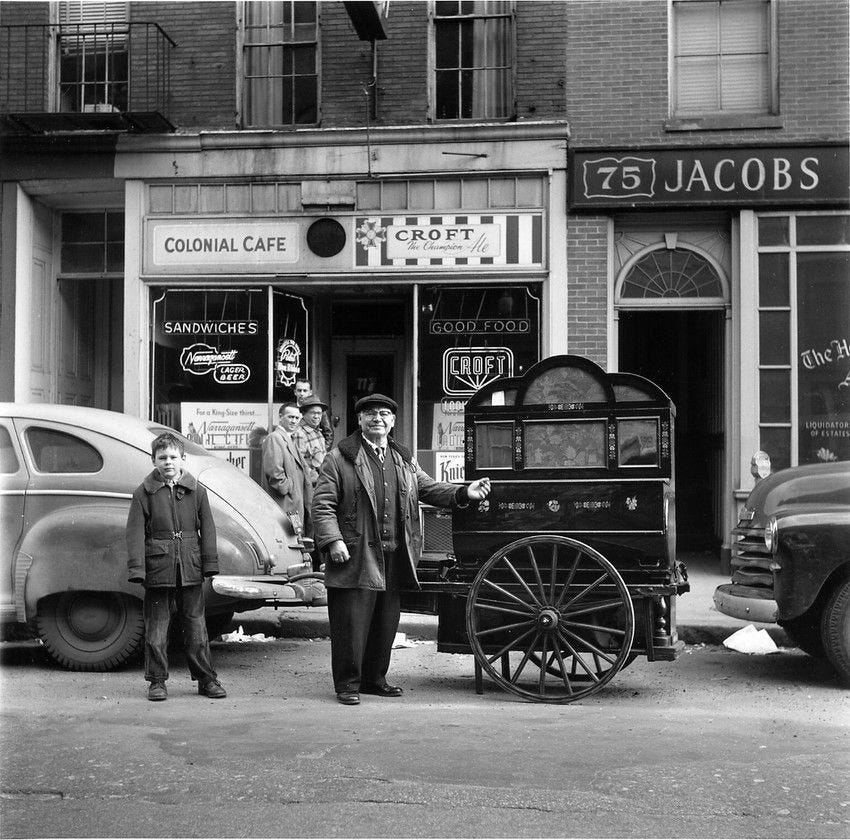Organ finder
When Tony Gangi discovered a 125-year-old street piano, he knew he had to have it
Let’s get something straight right from the start. Despite the (clever?) headline above, this story is not about an organ.
That’s what many people call the amazing instrument that Tony Gangi wheeled out of his garage on McKay Street on Monday and played for me in his driveway as the afternoon traffic whizzed by.
But, as Gangi quickly pointed out, it’s actually a street piano, sometimes called a hurdy gurdy. Whatever you call it, it now belongs to Tony and his wife, Suzanne. And thanks to their efforts, its sounds could be coming soon to a street near you.
The Gangis went to great lengths to buy and restore the instrument. It was made in 1899 and owned for decades by Marino Persechini, who played it for a living on the streets of Boston until 1974, when he turned 94.
Persechini sold it to an antique store when he retired. But last year, a friend of Tony’s who lives in New Hampshire said he spotted it at his neighbor’s house. Gangi’s not entirely sure how it ended up there, but he knew one thing — he had to have it.
That sentiment is understandable if you know Tony’s story. He’s an organ grinder himself. On nice summer days you can find him playing on Boston Common or the streets of Salem. He’s also an expert on the history of organ grinders — not to mention a magician and a teacher at North Shore Community College.
So the Gangis ended up buying the Persechini piano and taking it up to Rochester, New York, to have it restored. They even traded in their Toyota Sienna for a Tacoma pickup truck and bought a trailer so they could haul it back home. The thing weighs a lot (Gangi wasn’t sure exactly how much) and can only be moved on a cart with big wheels.
Gangi didn’t want to say how much this all cost them. (He started a gofundme to help pay for the restoration.) But he sure sounded like it was worth it.
“What’s most important is the way it is linked to the immigrant experience in the early 20th century,” he told me. “For Italian-Americans, this was a major piece of income for them. They would feed their families with this.”
As for the sound, Gangi, who owns three other organs, called it “completely different.” In addition to the piano keys, there are two drums, a cymbal and seven little bells that make up the sound. There’s an upside-down tambourine attached the the side where people can leave a tip.
The piano plays 10 songs, all “pre-programmed” on a rolling barrel that you turn with a crank.
Take a listen for yourself:
Gangi said organ grinders were ubiquitous on the streets of many major American cities until the 1930s, when New York City’s mayor, Fiorello La Guardia, banned them. La Guardia said that type of entertainment was no longer needed with the advent of TV and movies, and the crowds that gathered around them spilled onto the street and disrupted traffic. Gangi also pointed out that the monkeys that often accompanied organ grinders were trained to pickpocket their customers.
But Gangi said La Guardia’s real motivation for the ban might have been an insult he got as a young Italian-American kid, when someone called him a “monkey grinder.”
“He really wanted to squash the stereotype of the Italian-American as organ grinder,” he said.
Gangi said he’s not sure how many street pianos like his are around anymore. But he’s determined to let as many people as possible hear its unique sound. He plans to play it on Boston Common and anyplace else that people will have him, including at parties.
“I want people to hear it,” he said. “It lived a full life and it’s not dead yet.”





Awesome article! I hope I get to hear it
live some day. Wonderful story!